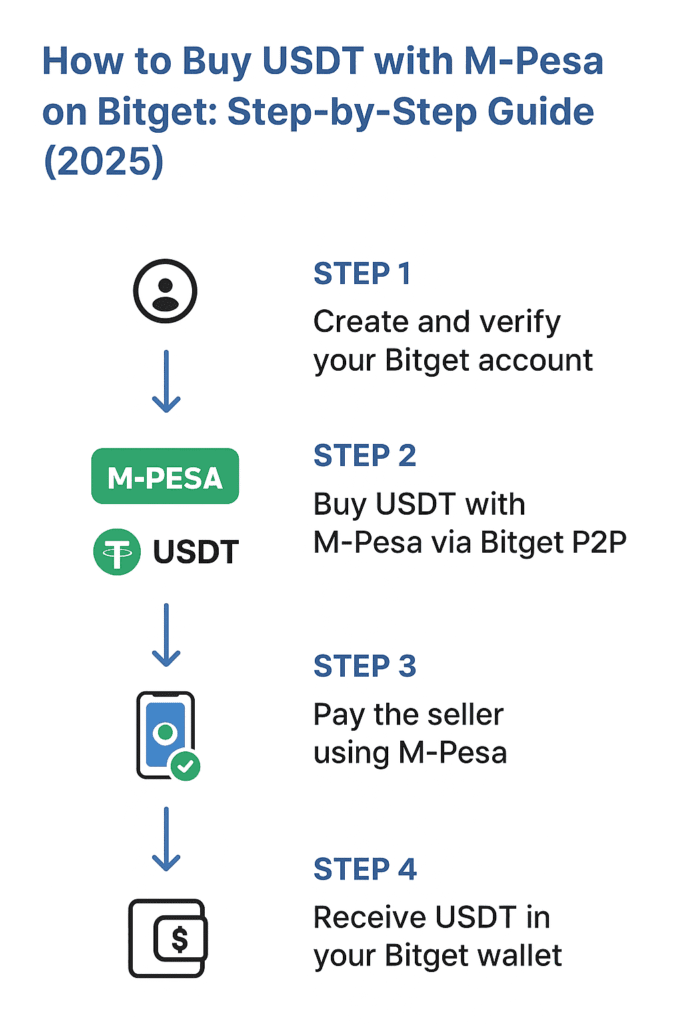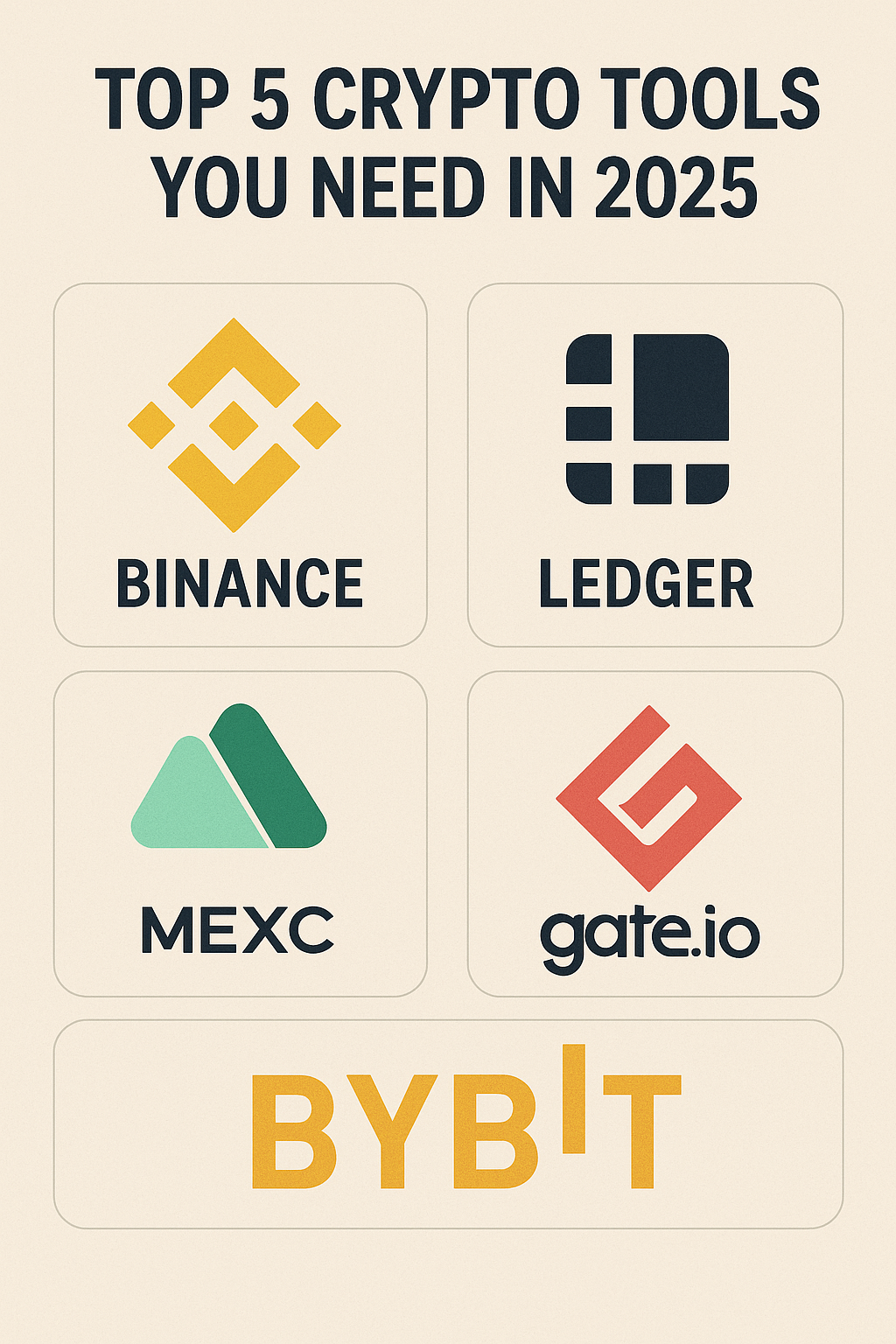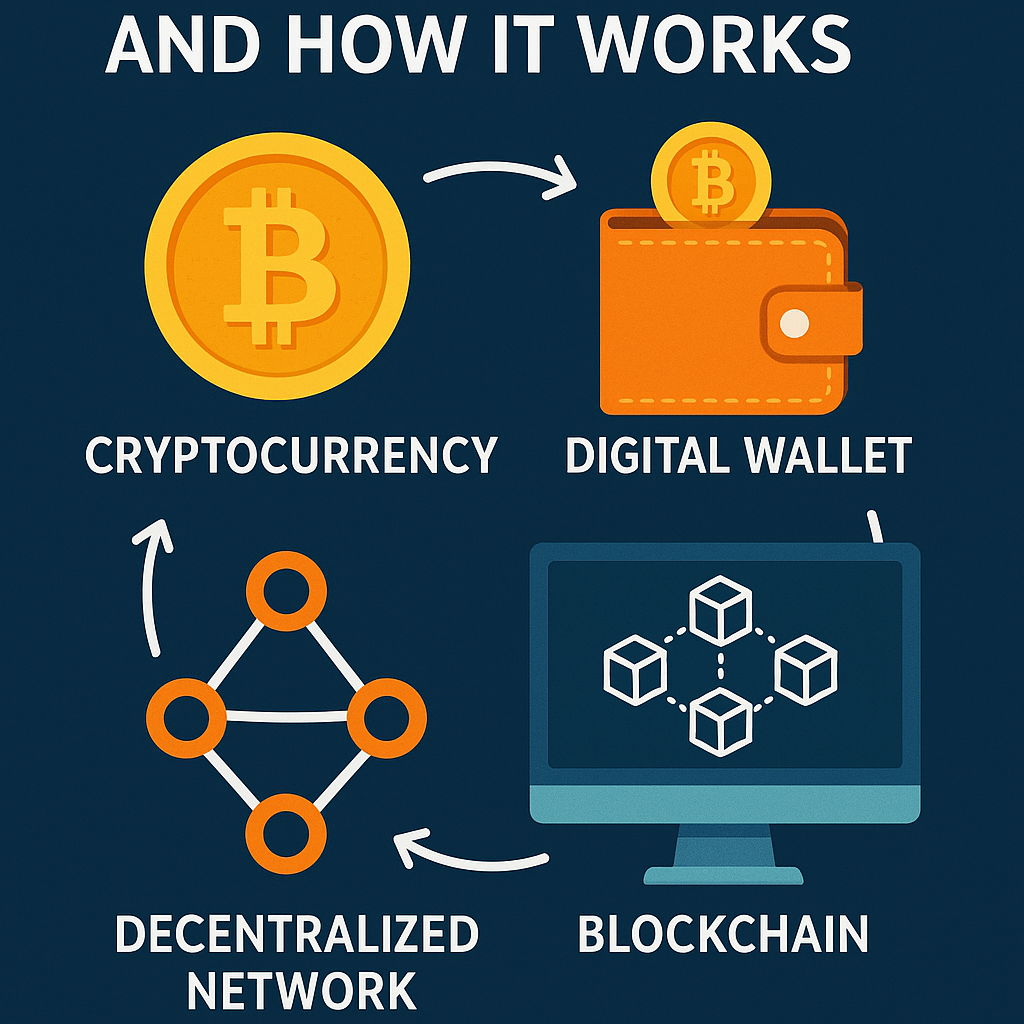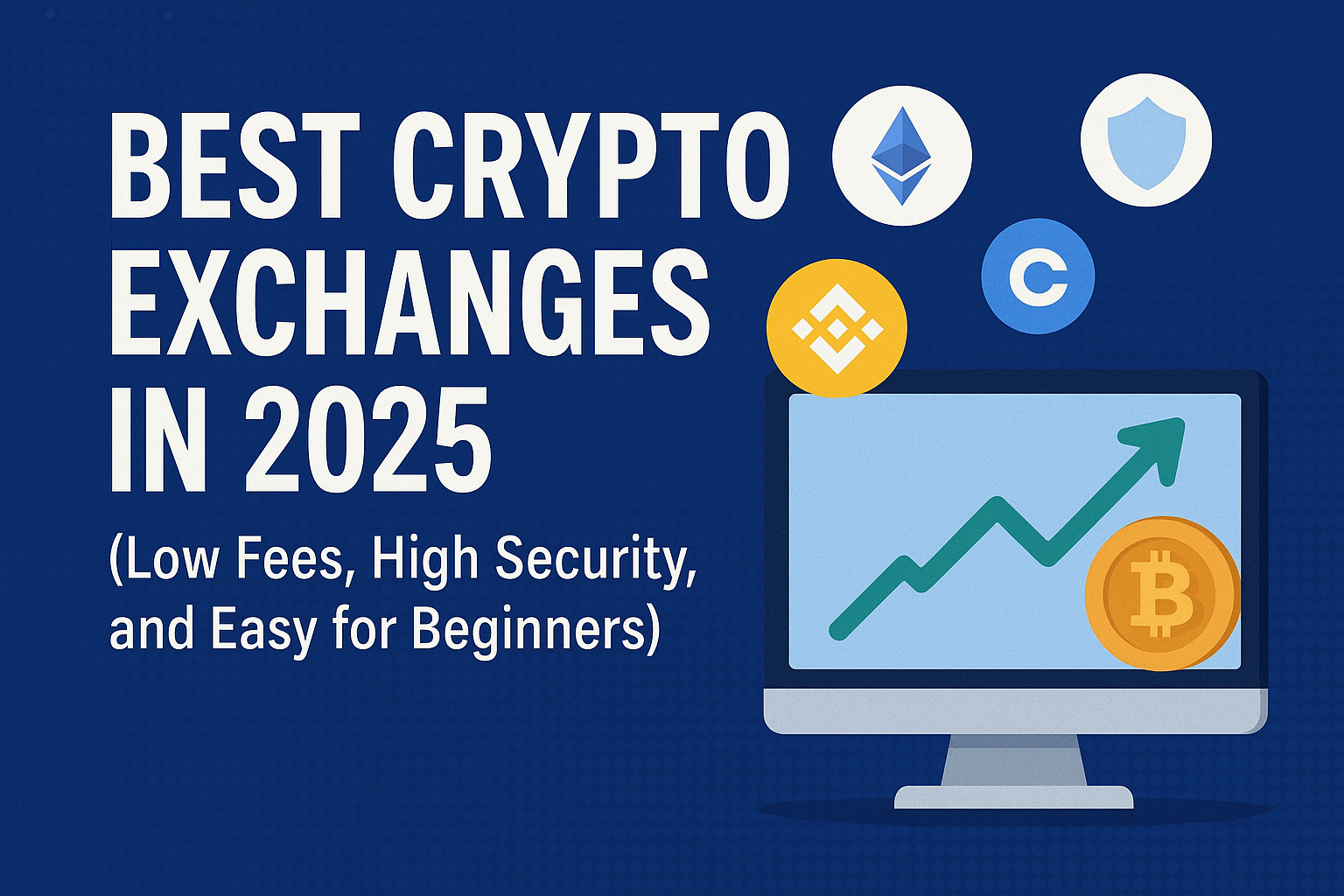Introduction: How to Buy USDT with M-Pesa on Bitget
In this tutorial we will take you through step-by-step on how to buy USDT with M-Pesa on Bitget. Kenyan customers can buy USDT straight on Bitget P2P through M-Pesa. This step-by-step guide shows you how to buy USDT securely, efficiently, and at low cost, ensuring a smooth process from payment to receiving your crypto.
Cryptocurrency uptake in Kenya has been in an explosive surge, and M-Pesa continues to be right in the middle of it all. With millions of Kenyans using M-Pesa in their daily transactions, no surprise that traders are eager to utilize it to access digital currencies like USDT (Tether), which is the most widely used stablecoin globally.
In 2025, one of the world’s most rapidly expanding crypto exchanges, Bitget, formally introduces M-Pesa as a payment method via its P2P marketplace. No longer do third-party platforms like Paxful or Paybis need to facilitate the connection—Kenyan traders can now buy USDT via M-Pesa within Bitget’s own system.
This guide will take you through everything you need to know: how it works, why Bitget is an awesome choice, step-by-step buying guide, security tips, and pro hacks for maximizing its use.
What is USDT

- USDT (Tether) is a stablecoin, a crypto that’s pegged to the US dollar. That is, 1 USDT tries to be close to 1 USD.
- It can exist on multiple blockchains (e.g. Ethereum, Tron, etc.), with different token standards (ERC-20, TRC-20, etc.). The blockchain generally does matter for fees and speed.
What is the Kenyan Shilling (KES)
KES is the currency of Kenya. Sometimes shortened to KSh or simply “Shilling.”
It’s issued by the Central Bank of Kenya. Its exchange value (exchange rate) with foreign currencies is determined by supply/demand, inflation, interest rates, etc.
Exchange Rate: USDT to KES
There is essentially no volatility in the USDT ↔ USD peg, so most of the movement in USDT→KES is a result of USD ↔ KES movements (i.e. how well the Shilling is performing compared to the dollar).
M-Pesa and USDT in Kenya
M-Pesa is Kenya’s leading mobile money platform, operated by Safaricom. It allows users to send, receive, and store money directly on their phones without needing a bank account. With over 30 million active users in Kenya, it has become the backbone of digital payments — powering bill payments, merchant transactions, and international remittances.
When it comes to USDT ↔ KES, M-Pesa often acts as the cash-out and cash-in channel. For example:
- Buying USDT with M-Pesa: Many crypto exchanges and P2P marketplaces (like Binance P2P, OKX P2P, Bitget P2P) allow you to pay in KES via M-Pesa to receive USDT in your wallet.
- Selling USDT to M-Pesa: The reverse also works — you sell your USDT to another user or platform and get paid in Kenyan Shillings directly into your M-Pesa wallet.
This link between USDT and M-Pesa has made stablecoins especially popular in Kenya, because it combines global digital currency with local everyday payments. People use it for:
- Remittances: Cheaper than traditional banks.
- Trading & savings: Store value in USDT, cash out to M-Pesa when needed.
- Everyday spending: Convert only the amount you need into KES for bills, shopping, or sending money to family.
Where / How to Convert USDT ↔ KES
People in Kenya like to convert or spend USDT in the following ways:
- Crypto exchanges
- Exchanges like Bitget, Bybit, Gate.io and etc., offer live trading or conversion pairs (USDT/KES). You can sell USDT for KES or vice versa.
- Be aware of fees, minimums, and withdrawal conditions.
- Peer-to-peer (P2P) / Local sellers
- You should be able to find Kenyans to sell USDT directly or on P2P markets for KES. Terms will vary, and trust is paramount.
- Fiat on-/off-ramps
- Some services allow you to buy USDT using KES (credit/debit card, bank deposit) or exchange USDT into KES and send the money (to bank or mobile money).
- Example: You can buy USDT (TRC-20) with Kenyan Shilling at ChangeNOW.
- And also, some services offer the possibility of exchanging crypto to cash in Kenya, sometimes by M-PESA or bank accounts.
- Wallets / Crypto apps
- Certain mobile wallets/apps come with an in-built converter or do offer a transfer to bank/M-PESA once converted from USDT.
Factors Affecting the USDT-KES Rate
USDT may be stable against the USD, but there are several moving pieces involved in converting to KES. These are some of the major influences:
- Macro-economic drivers on USD to KES: Kenya inflation, Kenya foreign exchange reserves, demand for USD, Kenya interest rates, government policy.
- Local supply/demand of USDT: When many people want USDT (for remittances, saving, trading), but there isn’t much available locally, it may affect the premium.
- Fees and transaction costs: blockchain fees, exchange/platform fees, withdrawal and deposit fees may alter what you get or pay.
- Regulation: any limits on crypto, foreign exchange regulations, or remittance regulations, etc., that Kenya or overseas exchanges have.
- Liquidity of pairing: Number of exchanges or platforms that support USDT/KES directly versus an intermediate (e.g. USDT → USD → KES) step.
Risks & Considerations while buying USDT With M-Pesa
- Even though USDT is stable in USD, there is counterparty risk (quality of issuer, audit, reserves), especially if carrying high amounts.
- Beware of scams on P2P trades: have a sure counterparty.
- Regulatory risk: regulation can shift for crypto conversion, taxation, etc.
- Slippage: A big trade can shift the rate if liquidity is poor.
- Additional fees: Withdrawal charges, minimums, delay in converting or cashing out.
Practical Tips for Kenyans When Buying USDT With M-Pesa
- Compare rates on several exchanges before exchanging; a few shillings per USDT difference can add up for large amounts.
- Consider the overall cost (exchange fee + blockchain’s gas fees + local mobile money / bank fees).
- Use platforms with good reputation, good reviews, and local support.
- Keep an eye on the USD/KES movement (e.g. how the Shilling is doing) because it affects how much KES you’ll get.
Why USDT and Why Bitget?
Let’s first see why USDT (Tether) and Bitget are such powerful tools for Kenyan traders before we move through the steps.
Why USDT?
- USDT is a stablecoin, pegged 1:1 to the US dollar.
- Unlike volatile coins like Bitcoin or Ethereum, USDT enjoys a stable price.
- USDT is used by traders as a stable store of value, base currency for trading, and bridge between fiat and cryptocurrency.
Why Bitget?
Bitget has positioned itself as a top 5 crypto exchange in the world, with millions of users worldwide. For Kenyans, Bitget offers:
- M-Pesa integration via P2P – convenience to sell and buy crypto in KES.
- Zero trading fees on P2P transactions.
- Advanced trading functions like spot, futures, and copy trade.
- High liquidity as well as strong security.
- Growing African focus, therefore local trader-centric.
Step 1: Create and Verify Your Bitget Account

To use Bitget P2P and buy USDT with M-Pesa, you first need a verified account.
- Download the Bitget App or visit Bitget’s website.
- Register with your email, phone number, Google, or Apple ID.
- Finish KYC Verification:
- Submit a real government-issued ID (Kenyan ID, passport, or driver’s license).
- Take a selfie for facial recognition.
- After verification, you unlock:
- P2P trading (with M-Pesa).
- Higher deposit and withdrawal limits.
- More account security features.
Pro Tip: Do not skip KYC. Bitget requires it for M-Pesa transactions, and it ensures you’re trading in a secure environment.
Step 2: Proceed to Bitget P2P Trading
Once your account has been verified:
- Go to the P2P Trading menu on the app or website.
- Select Buy → USDT.
- Set fiat currency as KES (Kenyan Shilling).
- You can see a list of sellers offering USDT with various payment methods.
- Identify especially those sellers who are able to accept M-Pesa.
Step 3: Select a Reliable Seller
On the P2P page, you can find different sellers with different rates and limits. Here is what you need to look for:
- Price (Rate per USDT) – Choose a competitive rate but avoid very cheap deals.
- Completion Rate – Sellers with 95%+ completion rates are preferable.
- Order Volume – Sellers with higher completed trade volume are more reliable.
- Limits – Ensure the seller’s minimum and maximum trade amount is equal to what you want to buy.
Once you’ve found a trustworthy seller:
- Enter the amount of KES or USDT you wish to purchase.
- Click Buy USDT to start the process.
Step 4: Pay the Seller using M-Pesa
After you’ve placed the order:
- Bitget will display the pay info of the seller’s M-Pesa.
- Open your M-Pesa app or menu.
- Send the same amount to the seller’s account.
Once you’ve made the payment, return to Bitget and click “I have paid”.
The payment is being confirmed.
Step 5: Receive USDT in Your Bitget Wallet
Once the seller verifies your payment:
- The USDT is released from escrow to your Bitget wallet.
- You will be notified immediately.
This escrow system is safe—sellers won’t run off with your cash because Bitget is keeping the crypto until both of you have agreed.
Step 6: Start Using Your USDT
With USDT in your Bitget wallet, you can now:
- Exchange it for Bitcoin, Ethereum, or other cryptocurrencies.
- Trade it for futures.
- Explore copy trading, where you follow top traders’ strategies.
- Transfer it to other wallets or exchanges.
For withdrawals, use networks like TRC-20 (Tether on Tron) for low fees.
Security and Safety Hacks for Kenyan Traders
It is simple to buy crypto via P2P, but you need to be smart:
- Use Escrow Only – Always pay within Bitget. Never send money off the platform.
- Verify Details Thoroughly – Check seller details prior to paying with M-Pesa.
- Avoid Suspicious Deals – Avoid rates that are too good to be true.
- Start Small – When doing your first transaction, try it with a smaller amount.
- Enable 2FA – Lock your Bitget account with Google Authenticator or SMS codes.
Why M-Pesa + Bitget Is a Game-Changer for Kenya
Kenya has the highest rate of crypto adoption in Africa, and M-Pesa is the cause. When paired with Bitget, they open massive benefits:
- Accessibility – Anyone with a phone and M-Pesa can now have access to global crypto markets.
- Speed – Settlements are done in minutes.
- Low Cost – There are no P2P fees, and M-Pesa is extremely cheap.
- Trust – Escrow protects buyers and sellers.
- Flexibility – Buy small amounts to start off, or step up to larger trades.
USDT and M-Pesa in Kenya: The Bridge Between Crypto and Everyday Payments
In Kenya, M-Pesa has transformed the way people handle money. As a mobile money service with over 30 million active users, it enables instant transfers, bill payments, and merchant transactions without requiring a traditional bank account. At the same time, USDT (Tether) has grown into the most widely used stablecoin in the world, offering a digital alternative to the US dollar. The combination of these two systems — USDT and M-Pesa — is creating a new way for Kenyans to move value between crypto and local currency.
Why M-Pesa Matters for USDT Users
M-Pesa is deeply integrated into Kenya’s economy. Salaries, rent, shopping, school fees, and even rural remittances often move through M-Pesa. For anyone using USDT, being able to convert directly to or from M-Pesa is essential. Without this bridge, stablecoins would remain isolated in digital wallets and exchanges.
With USDT ↔ M-Pesa integrations, crypto becomes practical. Kenyans can:
- Buy USDT with M-Pesa: Most major exchanges like Binance, OKX, KuCoin, and Bitget offer P2P (peer-to-peer) markets where buyers can pay sellers directly using M-Pesa. This makes it simple to enter crypto using only a phone number and mobile wallet.
- Sell USDT to M-Pesa: The reverse is just as easy. By selling USDT to P2P buyers or service providers, users can cash out to Kenyan Shillings instantly in their M-Pesa wallet.
Use Cases of USDT with M-Pesa
- Remittances
Many Kenyans abroad send money home through traditional services with high fees. By sending USDT, families can receive funds quickly and cash out into KES via M-Pesa, saving on costs. - Savings and Inflation Protection
USDT is pegged to the US dollar, making it more stable than the Kenyan Shilling, which has been weakening against major currencies. People use USDT to store value, and when needed, withdraw KES through M-Pesa for daily use. - Trading and Business Payments
Local traders and freelancers who get paid in crypto often convert their USDT earnings into M-Pesa to pay suppliers, cover expenses, or shop locally. - Everyday Spending
Instead of cashing out everything, users convert only what they need. For example, someone holding $500 in USDT can sell $20 worth into M-Pesa today to pay for groceries, and another $50 next week for rent.
Advantages of Using USDT with M-Pesa
- Speed: Transactions settle within minutes.
- Low cost: Often cheaper than banks or international remittance services.
- Accessibility: No need for a bank account — just a Safaricom line.
- Flexibility: Easy to move between global crypto markets and local spending.
Risks to Keep in Mind
- Scams on P2P platforms: Always trade with verified buyers/sellers.
- Regulatory changes: Kenya is still shaping its crypto regulations.
- Fees: M-Pesa charges standard transaction fees, and some exchanges add small service costs.
Common FAQs About Buying USDT with M-Pesa on Bitget
Can I buy USDT directly with M-Pesa on Bitget?
Yes. Bitget’s P2P platform supports M-Pesa as a payment option for Kenyan buyers.
How fast does it occur?
Most trades are completed in under 10 minutes after the seller has confirmed your M-Pesa payment.
Is there a buying cap?
Yes, listing limits are dependent on sellers. For high values, choose sellers with high trade limits.
Which network do I use when I’m sending USDT?
TRC-20 is lowest and quickest, but always check with the receiver first and then transfer.
Do I need to do KYC to access M-Pesa on Bitget?
Yes, you need to do KYC to be compliant and to provide P2P trading.
Pro Tips for Advanced Traders
- Use Multiple Sellers – Don’t rely on one seller but use multiple trusted sellers.
- Check Exchange Rates – USDT/KES prices vary by seller. Check and compare first before buying.
- Leverage Bitget Offers – Bitget will most likely have cashback or bonus promotions for P2P traders.
- Arbitrage Opportunities – Some traders buy USDT on Bitget via M-Pesa and sell on some other platform to gain profits.
Conclusion
Buying USDT with M-Pesa is easier than ever before on Bitget. Thanks to Bitget’s direct P2P connection with M-Pesa, Kenyan traders enjoy instant, secure, and low-cost access to the global crypto market.
By following this step-by-step guide, you can:
- Create and confirm your Bitget account.
- Purchase USDT directly with M-Pesa.
- Get crypto safely deposited into your wallet.
- Begin trading, investing, or holding assets.
This combination of local convenience (M-Pesa) and global access (Bitget) is transforming how Kenyans participate in the crypto economy—and it’s just the beginning.
You can also read: Ultimate Guide to Buying Crypto with M‑Pesa via Bybit, Bitget, & Gate.io in Kenya [2025]
:Best Crypto Exchanges in 2025 (Low Fees, High Security, and Easy for Beginners)



